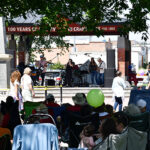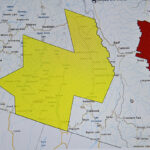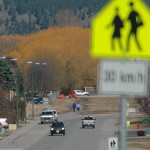Home »
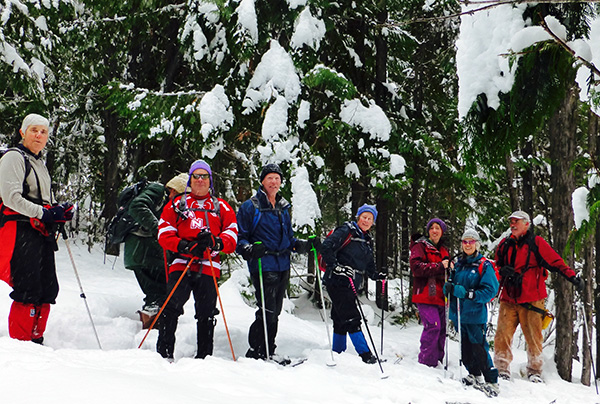
Searching for signs in the Moyie drainage
Now that the excitement of the Christmas Bird Counts has subsided, naturalists turn their attention to the comings and goings of animals that make their living in the winter landscapes of the East Kootenay.
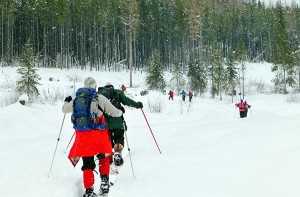 On several occasions, naturalists have strapped on the snowshoes and headed off into the deep snows of the local area. One favourite spot is situated about 10 kilometres up the Moyie River drainage, an area exhibiting both East Kootenay and West Kootenay influences.
On several occasions, naturalists have strapped on the snowshoes and headed off into the deep snows of the local area. One favourite spot is situated about 10 kilometres up the Moyie River drainage, an area exhibiting both East Kootenay and West Kootenay influences.
There isn’t really much of a creek at Salesbury Creek, but there is forest diversity, some logging and an old trail. Armed with our ‘track’ guidebooks, a little background knowledge and a willingness to learn, we tromped up the hill.
Once you begin tracking, you soon discover there is a whole new world out there with many riddles and scenarios waiting to be revealed. If you allow yourself to be right and rely on your hunches and intuition, the puzzles can eventually be solved. Observe the little threads of evidence and blend these with the larger picture. Chances are you will be right more often than not.

Soon we came across the trail of something big and heavy. Looking right and left, we saw that, whatever it was, had been clipping off some willow tips. In fact, it looked like there was a ‘big one’ and a ‘smaller one’. Greg ventured off to the side and luckily found a small pile of poop, which he shared with us. Now we were fairly confident that this puzzle could be solved. A cow and calf moose were up there somewhere. The next curiosity was a very faint, skinny streak, actually several little direct lines. Something very small had tried to climb the slope. We could see tiny hopping prints which were partially obscured by a dusting of fresh snow
Evidently, one or more Dusky Shrews had made repeated passes in an attempt to find something to eat. Now we could check off two animals, one of which weighed about 100,000 times more than the other.
Identifying tracks to the species level is much easier if you first look for certain clues. Those clues are not usually found in the track. Only one in 100 tracks show clear detail like toe or nail marks. By far, the two most useful clues to look for are the track ‘pattern’ and the overall trail width that the pattern makes.
Many animals have four legs and an ability to change their speed. Therefore, it is somewhat complicated to ID their track patterns. In an effort to conserve energy, there are distinct patterns that the various species use most of the time, so it is useful to group the animals by their ‘regular’ walking pattern. There are four basic patterns: Pace, Diagonal, Bound and Gallop.

Of course, animals and birds also make ‘signs’ as they go about their business. We encountered a group of live trees where, perhaps 50 years ago, a black bear had stripped away the bark near the base of some spruce and balsams. In an effort to obtain nourishment in late winter when new, leafy greenery has not yet emerged, bears will seek the cambium and inner bark of trees.
The tree crowns will be responding to the warm April sunshine at the same time that their feet are still in the cold, snowy ground. The sap is starting to flow and bears will capitalize. One more recently stripped tree had been weakened enough so that bark beetles had gained the upper hand. Something, perhaps a Three-toed Woodpecker, had made numerous pits in the bark of the now dead tree. If the activity was recent, we might have seen bark flakes on the snow.
Piles of broken fir and spruce cones accumulate where squirrels perched on a prominent root or branch, and repeatedly sought the nourishing seeds within the cones. It was not surprising to see Pine Marten tracks in the snow near these middens, the squirrels` main predator.
Next time we search for tracks, we’ll use some newfound skills. When the sun is low and casting long shadows, track depressions will darken, while scuff marks will lighten up. Even if we can’t easily determine the number of toes or the shape of the heel pad, we’ll reach down and feel the tracks with our fingers. If a track is snowed-in we’ll simply dig down to the original track and feel for it. It will be firm from the compression of the snow and may actually be like a chunk of ice.
Not many birds were seen that afternoon, but we got one of the biggest, most striking forest birds on the continent. Nearly the size of a crow, black with bold white stripes down the neck and a flaming red crest, it drummed on the tip of a tall, dead Western Larch. The distinctive, heavy, ‘thunk’ of the Pileated Woodpecker could be heard at a great distance.
Pileateds live in mature deciduous or mixed deciduous-coniferous woodlands of nearly every type, from tall Western Hemlock stands of the West Coast, to Beech and Maple forests in New England and Cypress swamps of the southeast. Besides younger forests with a good supply of downed wood, suburban areas with large trees and patches of woodland provide good habitat.

Large, rectangular excavations which pursue the tunnels of carpenter ants indicate the presence of the Pileated. These excavations can be so broad and deep, that, in the wind, small trees will break and fall. In addition to carpenter ants, these birds seek woodboring beetle larvae, termites, spruce budworm, caterpillars and grasshoppers. They also eat wild fruits and nuts, and occasionally will visit backyard bird feeders for seeds or suet.
A Pileated pair stays together on it’s territory all year round. Defensive in all seasons, they will tolerate new arrivals during the winter. It’s rare to see more than two birds together at a time, as Pileateds are monogamous and hold large territories. With a lifespan of 10 or more years, if a member of a pair dies, the other often gains a new mate. New individuals then get a chance to breed and hold a territory.
The female Pileated lays one clutch per breeding season. With four eggs being most common, one to six are possible. The eggs are white and slightly glossy and are incubated by both adults. Following 15-18 days of incubation, both adults alternately feed the young in the nest cavity for 24-28 days. After three to five months, the young leave the adults but do not venture far from the natal territory.
The Pileated Woodpecker is an extremely important part of the forest ecosystem, as it’s excavations provide shelter for many other species including Swifts, Owls, Bats and Pine Martens.
Although it is a relatively common and abundant species, Woody is under threat from collisions with road traffic and increased predation from habitat loss. The location of its roosts and nests in tall trees puts it at risk from lightening strikes. Also, its attempts to create roosts in creosote-treated utility poles can cause the death of eggs and nestlings.
According to the North American Breeding Bird Survey, populations have steadily increased over the last 50 years. It is important for property owners and forest managers to maintain large, standing dead trees and fallen logs. These elements provide insect food and the cavities, which are needed by many species of birds and mammals. Historically, Pileateds probably declined greatly with the clearing of the Eastern forests, but rebounded in the mid-20th century as these forests grew back. More research is needed into the Pileated’s biology and the effects of human disturbances on its population.
The List
Dusky Shrew 3 grams
Masked Shrew 7 grams
Deer Mouse 28 grams
Three-toed Woodpecker 65 grams
Short-tailed Weasel 70-200 grams
Long-tailed Weasel 130-150 grams
Western Red Squirrel 225 grams
Pileated Woodpecker 250-350 grams
Pine Marten 0.5-1.8 kg
Snowshoe Hare 1.8 kg
Canada Lynx 6.8-14 kg
Timber Wolf 32-54 kg
Mule Deer 68-92 kg
Moose 400 kg
Lead image: Marianne, Lloyd, George, Bruce, Charlene, Myra, Paula, Daryl. Photos submitted
– Submitted by Daryl Calder on behalf of Rocky Mountain Naturalists

